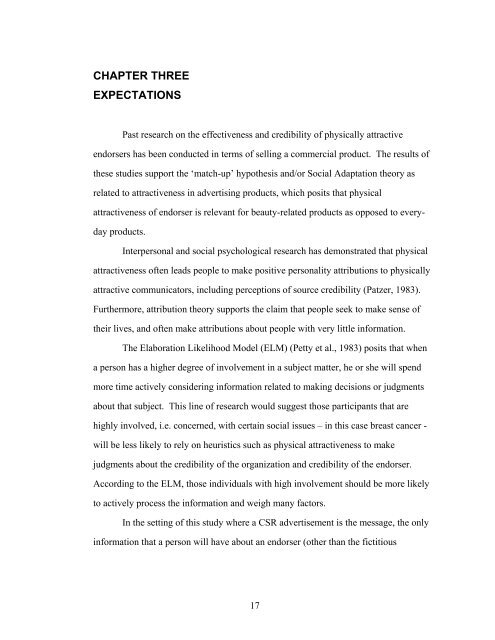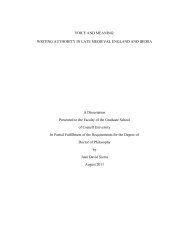Briana Anderson - Cornell University
Briana Anderson - Cornell University
Briana Anderson - Cornell University
Create successful ePaper yourself
Turn your PDF publications into a flip-book with our unique Google optimized e-Paper software.
CHAPTER THREE<br />
EXPECTATIONS<br />
Past research on the effectiveness and credibility of physically attractive<br />
endorsers has been conducted in terms of selling a commercial product. The results of<br />
these studies support the ‘match-up’ hypothesis and/or Social Adaptation theory as<br />
related to attractiveness in advertising products, which posits that physical<br />
attractiveness of endorser is relevant for beauty-related products as opposed to every-<br />
day products.<br />
Interpersonal and social psychological research has demonstrated that physical<br />
attractiveness often leads people to make positive personality attributions to physically<br />
attractive communicators, including perceptions of source credibility (Patzer, 1983).<br />
Furthermore, attribution theory supports the claim that people seek to make sense of<br />
their lives, and often make attributions about people with very little information.<br />
The Elaboration Likelihood Model (ELM) (Petty et al., 1983) posits that when<br />
a person has a higher degree of involvement in a subject matter, he or she will spend<br />
more time actively considering information related to making decisions or judgments<br />
about that subject. This line of research would suggest those participants that are<br />
highly involved, i.e. concerned, with certain social issues – in this case breast cancer -<br />
will be less likely to rely on heuristics such as physical attractiveness to make<br />
judgments about the credibility of the organization and credibility of the endorser.<br />
According to the ELM, those individuals with high involvement should be more likely<br />
to actively process the information and weigh many factors.<br />
In the setting of this study where a CSR advertisement is the message, the only<br />
information that a person will have about an endorser (other than the fictitious<br />
17

















